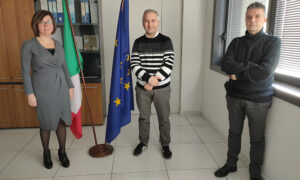.jpg) The international fair season will close with Filo, the international yarn and fiber fair, in its 39th edition, held on March 20 and 21, 2013 at Milan’s Le Stelline Congress Center.
The international fair season will close with Filo, the international yarn and fiber fair, in its 39th edition, held on March 20 and 21, 2013 at Milan’s Le Stelline Congress Center.
Filo has been sending out positive signs for a few years, with spinners relying on research and innovation and visitors satisfied with product quality. This year’s fair, which was established in Biella, opens up to the world, owing to the attendance of qualified foreign exhibitors and, hopefully, of many visitors from abroad, as has been occurring in the past few years, thanks also to the renewed cooperation with ICE, the agency for the promotion abroad and internationalization of Italian enterprises.
This year’s theme, chosen as usual by Gianni Bologna is “Prints”. “The Prints I chose for the product offerings of this Filo fair- explains Bologna- are the “tracks to be followed” in a déjà-vu blend of old and new, or the “prints we leave behind”, though we live in the era of speed and hyper-communication, or the “digitals marks”, represented by technical yarns placed side by side with natural and eco-friendly ones”. Prints running through the whole textile chain and ending up in the men’s and women’s garments that we will be seeing soon on runways and in the streets.
We had a talk with Paolo Monfermoso, the manager in charge of Filo, to learn about how the spinning sector is getting ready for the event.
What is the state of health of Italian spinners?
2012 was definitely not an easy year for the yarn industry: in addition to old problems (excessive taxation, labour cost and tax wedge, energy costs, bureaucracy), it had to face a serious financial crisis that has made access to bank credit much more difficult. And all this in a negative global context, in which even the emerging markets register a slowdown in growth. It is therefore inevitable that the economic situation affects the spinning sector too: the data for the first six months of 2012 show a drop in production that exceeds 15% and the final data for the whole year are not likely to show any recovery. However, the average data show different trends according to the kind of product, with worsted and carded woolen yarns doing better than cotton and man-made wool mixture yarns. Anyway, the yarn industry’s 2012 turnover will be equivalent to about € 3 billion. Let’s not forget that the sector has undergone serious restructuring in the past few years and is thus better equipped to face the crisis than others. That is why Filo faces 2013 with reasonable optimism, encouraged by the data on the exhibitors’ attendance at the March fair, in step with the past few years.
Speaking about “Prints”, what is today the way to success on the market?
Our business is based on several basic values: product quality, raw material quality, environmental protection, respect for people and their work. These are the “Prints” that have distinguished Filo from the very first and have allowed it to gain recognition on the international textile trade fair scene.
Once again, Filo is relying on foreign markets, thanks also to the cooperation with ICE: what new markets are the most appealing? Which among the traditional markets is still a fixture? Is there any hope for a recovery of the national market?
I would like to say a few words before answering your questions. The major market for top-quality yarns, like the ones introduced at Filo, is still Italy, because only Italy has been able to preserve its textile chain intact and that is the added value on which made-in-Italy quality is based. Just take a look at the data: over half of Italian yarn production is based in our country.
Generally speaking, Europe is still an interesting market. As far as non-European countries, the latest ICE reports show that Italy is China’s major woolen yarns supplier.
Is top quality still the best strategy? Do Filo’s exhibitors have enough profit margin to invest on innovation?
The highest product quality is the only option for Italian spinners. Research and development of innovative solutions are essential to spinners, these are the distinguishing features of Italian yarns and what allows them to beat the competition. Filo’s exhibitors know this very well, as proved by their collections every year.
La kermesse dei saloni internazionali volgerà alla fine con Filo, salone internazionale di filati e fibre, che presenterà la sua 39ª edizione per il 20 e 21 marzo 2013 al Centro Congressi Le Stelline di Milano.
Da alcune edizioni Filo lancia segnali positivi, con filatori che puntano sulla ricerca e sull’innovazione, con visitatori che premiano la qualità. Anche quest’anno la fiera che è nata a Biella si apre al mondo intero, per la presenza di qualificati espositori stranieri e per l’auspicato afflusso di visitatori stranieri, come avviene con costanza da alcune edizioni, grazie anche alla collaborazione con l'Ice-Agenzia per la promozione all'estero e l'internazionalizzazione delle imprese italiane, rinnovata anche per la prossima edizione.
Il tema di quest’anno, individuato come di consueto da Gianni Bologna, è ‘Impronte’.“Le Impronte che ho scelto per le proposte prodotto di questa edizione di Filo – spiega Bologna – Sono le “Orme da seguire” in un déjà-vu che mescola antico e moderno. Oppure sono le “Impronte che lasciamo”, pur vivendo al tempo della velocità e della iper-comunicazione. Oppure sono “Tracce digitali”, con i filati tecnici a fianco dei naturali ecologici e eco-compatibili”. Impronte, comunque, che percorreranno tutti gli anelli della filiera tessile, fino a ritrovarle nei capi per uomo e per donna che vedremo sfilare sulle passerelle prossime venture e poi nelle strade.
Per sapere come il settore si avvicina a quest’appuntamento, abbiamo parlato con Paolo Monfermoso, responsabile di Filo.
Qual è lo stato di salute dei filatori italiani?
Il 2012 non è stato certo un anno facile per l’industria dei filati: ai problemi denunciati da tempo (fiscalità eccessiva, costo del lavoro e cuneo fiscale, costi dell’energia, burocrazia) si è aggiunta una grave crisi finanziaria, che ha reso ancor più difficoltoso per le aziende il ricorso al credito bancario. Il tutto in un contesto internazionale negativo, nel quale anche i cosiddetti paesi emergenti registrano una contrazione della loro crescita. Inevitabile che la congiuntura si rifletta anche sul comparto della filatura: i numeri dei primi sei mesi del 2012 indicano un calo della produzione superiore al 15% e il dato definitivo per l’intero anno non registrerà prevedibilmente alcun recupero. Tuttavia, il dato medio nasconde andamenti diversi per le diverse tipologie di prodotto, con i filati di lana pettinata e i cardati che fanno meglio dei filati di cotone e dei misti man made-lana. Ciò detto, anche nel 2012 il fatturato dell’industria dei filati si attesterà sui 3 miliardi di euro. Né va dimenticato che il comparto è già stato interessato da una forte ristrutturazione negli anni passati ed è dunque meglio attrezzato di altri ad affrontare la crisi. Per questo Filo guarda al 2013 con un ragionevole ottimismo, confortato anche dai dati sulle adesioni degli espositori all’edizione di marzo, in linea con quelle degli anni passati.
A proposito di ‘Impronte’, qual è il percorso da seguire oggi per affermarsi sul mercato?
Tutta la nostra attività si fonda su alcuni valori per noi imprescindibili: qualità del prodotto, qualità delle materie prime, rispetto dell'ambiente e rispetto delle persone e del loro lavoro. Sono le “Impronte” che hanno caratterizzato Filo fin dalla sua prima edizione e che gli hanno permesso di assumere un ruolo riconosciuto nel panorama delle fiere tessili in
ternazionali.
Ancora una volta FILO punta sui mercati esteri, anche grazie alla collaborazione con Ice: quali nuovi mercati hanno oggi maggiore appeal? Quale dei tradizionali resta un consolidato punto fermo? C’è speranza per una ripresa del mercato domestico?
E’ necessaria una premessa. Il mercato più importante per filati di alta qualità, quali sono quelli presentati a Filo, resta l’Italia, perché solo l’Italia ha saputo mantenere una filiera integra ed è su questo plus che si fonda la qualità del made in Italy. D’altra parte, basta guardare i dati: oltre la metà della produzione italiana di filati resta nel nostro paese.
In generale, comunque, possiamo dire che l'Europa continua a essere interessante. Per quanto riguarda i paesi extra-Ue, invece, proprio gli ultimi rapporti Ice ci dicono che l’Italia è il primo fornitore di filati di lana in Cina.
L’alta gamma è ancora una scelta vincente? Gli espositori di Filo riescono ad avere margini di guadagno tali da investire sull’innovazione?
L’alta gamma – intesa come estrema qualità di prodotto – è l’unica scelta possibile per i filatori italiani. Così come non si può prescindere dalla ricerca e dallo sviluppo di soluzioni innovative, perché questo è il tratto distintivo dei filati made in Italy ed è quello che permette di vincere la competizione con le produzioni di altri paesi. Gli espositori di Filo l’hanno compreso molto bene, come dimostrano a ogni edizione con le loro collezioni.





